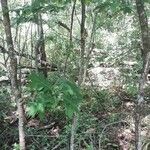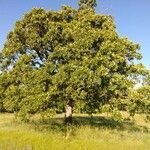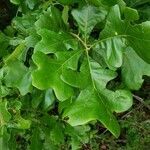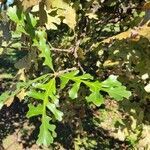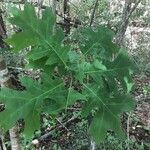Trees , deciduous, to 20(-30) m. Bark light gray, scaly. Twigs yellowish or grayish, (2-)3-5 mm diam., densely stellate-pubescent. Buds reddish brown, ovoid, to 4 mm, apex obtuse or acute, sparsely pubescent. Leaves: petiole 3-15(-30) mm. Leaf blade obovate to narrowly obovate, elliptic or obtriangular, 40-150(-200) × 20-100(-120) mm, rather stiff and hard, base rounded-attenuate to cordate, sometimes cuneate, margins shallowly to deeply lobed, lobes rounded or spatulate, usually distal 2 lobes divergent at right angles to midrib in cruciform pattern, secondary veins 3-5 on each side, apex broadly rounded; surfaces abaxially yellowish green, with crowded yellowish glandular hairs and scattered minute, 6-8-rayed, appressed or semi-appressed stellate hairs, not velvety to touch, adaxially dark or yellowish green, dull or glossy, sparsely stellate, often somewhat sandpapery with harsh hairs. Acorns 1-3, subsessile or on peduncle to 6(-40) mm; cup deeply saucer-shaped, proximally rounded or constricted, 7-12(-18) mm deep × (7-)10-15(-25) mm wide, enclosing 1/4-2/3 nut, scales tightly appressed, finely grayish pubescent; nut light brown, ovoid or globose, 10-20 × 8-12(-20) mm, glabrous or finely puberulent. Cotyledons distinct.
More
Small or large tree with thick, rough, deeply furrowed bark; lvs 9–15 × 5–10 cm, obovate or often cruciform, thick, variable, usually with a few large, rounded lobes, the main pair of lateral lobes usually constricted at base and with truncate to retuse tip, pubescent on both sides with erect, few-branched hairs, those of the upper surface often deciduous just above the base; petioles and twigs persistently pubescent; acorns sessile or nearly so, the cup hemispheric or pyriform, covering half the nut, its scales flat or nearly so; nut ovoid, 1–1.5 cm. Dry upland woods and barrens; se. Mass. and s. N.Y. to O., Ind., and s. Io., s. to Fla. and Tex., common along our s. border.
A deciduous tree. It grows 20 m high. It is a broadly spreading oak tree. The bark is grey-brown and ridged. It is flaky. The leaves are oval and 20 cm long by 10 cm wide. They have 2 or 3 pairs of lobes. They are dark green above and grey and hairy underneath. The male and female flowers occur separately on the same plant. The male flowers are easier to see and are yellow-green in drooping catkins. The fruit is an acorn which is 3 cm long. It is about one third enclosed in a cup.
Rocky or sandy ridges and outcrops, also in dry woodlands in a variety of soils including gravelly, sandy, poor upland soils and heavy moist loamy soils, where it reaches its greatest height; at elevations from 900-1,500 metres.
More
It is a temperate plant. It is native to C. and E. United States. It grows in dry soil.
